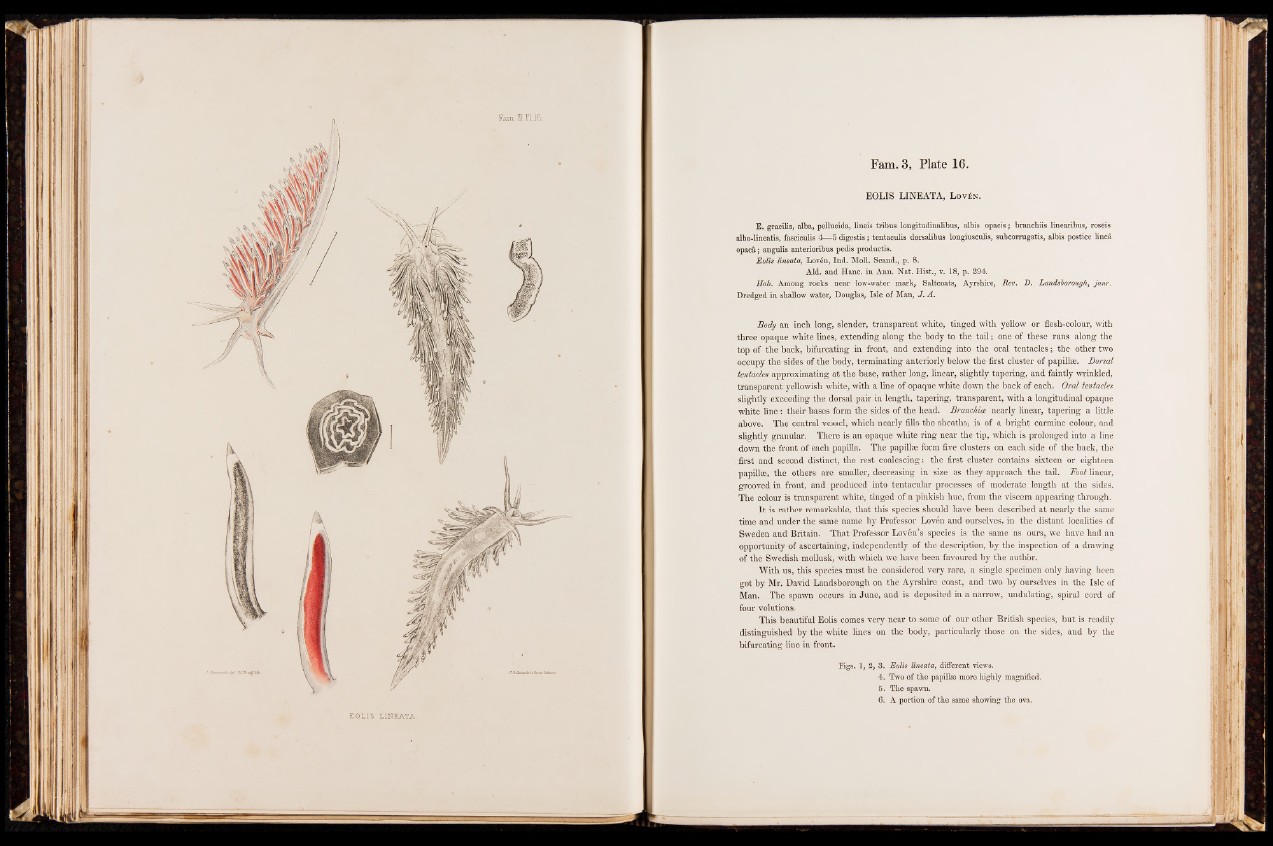
EOLIS LINEATA.
EOLIS LINEATA, L ovIsn.
E. gracilis, alba, pellucida, lineis tribus longitudinalibus, albis opacis; branchiis linearibus, roseis
albo-lineatis, fasciculis 4—5 digestis; tentaculis dorsalibus longiusculis, subcorrugatis, albis postice linea
opaca j angulis anterioribus pedis productis.
Eolis lineata, Loven, Ind. Moll. Scand., p. 8.
Aid. and Hanc. in Ann. Nat. Hist., v. 18, p. 294.
Hab. Among rocks near low-water mark, Saltcoats, Ayrshire, Rev. D. Landsborough, junr.
Dredged in shallow water, Douglas, Isle of Man, J. A.
Body an inch long, slender, transparent white, tinged with yellow or flesh-colour, with
three opaque white lines, extending along the body to the tail; one of these runs along the
top of the back, bifurcating in front, and extending into the oral tentacles; the other two
occupy the sides of the body, terminating anteriorly below the first cluster of papillae. Dorsal
tentacles approximating at the base, rather long, linear, slightly tapering, and faintly wrinkled,
transparent yellowish white, with a line of opaque white down the back of each. Oral tentacles
slightly exceeding the dorsal pair in length, tapering, transparent, with a longitudinal opaque
white line : their bases form the sides of the head. Branchiae nearly linear, tapering a little
above. The central vessel, which nearly fills the sheaths, is of a bright carmine colour, and
slightly granular. There is an opaque white ring near the tip, which is prolonged into a line
down the front of each papilla. The papillae form five clusters on each side of the back, the
first and second distinct, the rest coalescing: the first cluster contains sixteen or eighteen
papillae, the others are smaller, decreasing in size as they approach the tail. Foot linear,
grooved in front, and produced into tentacular processes of moderate length at the sides.
The colour is transparent white, tinged of a pinkish hue, from the viscera appearing through.
It is rather remarkable, that this species should have been described at nearly the same
time and under the same name by Professor Loven and ourselves, in the distant localities of
Sweden and Britain. That Professor Loven’s species is the same as ours, we have had an
opportunity of ascertaining, independently of the description, by the inspection of a drawing
of the Swedish mollusk, with which we have been favoured by the author.
With us, this species must be considered very rare, a single specimen only having been
got by Mr. David Landsborough on the Ayrshire coast, and two by ourselves in the Isle of
Man. The spawn occurs in June, and is deposited in a narrow, undulating, spiral cord of
four volutions.
This beautiful Eolis comes very near to some of our other British species, but is readily
distinguished by the white lines on the body, particularly those on the sides, and by the
bifurcating line in front.
Figs. 1, 2, 3. Eolis lineata, different views.
4. Two of the papillae more highly magnified.
5. The spawn.
6. A portion of the same showing the ova.